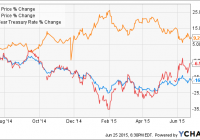PPL Remains On Track Despite Spin-Off
When a company spins off part of its business, it may look like shareholders lost money, but in most cases, it’s just a technical adjustment. PPL’s stock hasn’t “fallen,” per se, but instead PPL shareholders now own a portion of newly-created Talen Energy, a stake of which they can do with what they want. After the spinoff, PPL management reaffirmed its 2015 ongoing EPS guidance of $2.05-$2.25, as well as its expected earnings CAGR of 4%-6% through at least 2017. Certainly there’s been a lot of share-price noise at PPL as of late, but the firm continues to execute, and we still like the utility. By Kris Rosemann PPL Corp’s (NYSE: PPL ) shares have been adjusted lower recently, as the firm officially completed the spinoff of its energy supply business June 1. The move finalizes PPL’s transition to a focus on regulated utilities in the US and UK. PPL’s spinoff, now trading under the name Talen Energy Corporation (Pending: TLN ), also includes the addition of RJS Power of Riverstone Holdings. As previously announced , all of the common stock of Talen Energy will be distributed pro rata to PPL shareholders. PPL shareholders received ~.1249 shares of Talen Energy common stock for each share of PPL owned as of May 20. Fractional shares were not issued; instead they were aggregated and sold in the open market, with the cash proceeds distributed pro rata to PPL shareholders. The affiliates of Riverstone Holdings will receive common shares of Talen Energy in compensation for RJS Power, resulting in their owning 35% of Talen Energy. PPL shareholders will own 65%. After the spinoff, PPL management reaffirmed its 2015 EPS from ongoing operations guidance of $2.05-$2.25, as well as its expected compound annual earnings growth rate of 4%-6% through at least 2017. The firm expects substantial rate base growth in the coming years, projecting a CAGR of 7% through 2019, though we note currency headwinds from its UK operations will continue to negatively impact earnings in the near term. Management also stated as recently as February of this year that it expects dividend growth potential to become realizable following the spinoff. The dividend potential of Talen Energy remains to be seen, but the assets that make up the company generated $4.3 billion in revenue in 2014. The newly-created firm will boast a competitive cost structure and the financial agility to pursue additional growth options. At its inception, Talen’s generation capacity of about 15,000 megawatts will be primarily located in the Mid-Atlantic and Texas, two of the largest and most competitive energy markets in the US. Its generation mix is approximately 43% natural gas or oil, 40% coal, 15% nuclear, and 2% hydroelectric. The energy-generating plants will continue to be operated and maintained by the same employees before the spin off, and the firm’s leadership team is partially comprised of former PPL leadership. The drop in PPL’s share price should not come as a surprise, and intuitively, it makes sense. Though at face value it appears that PPL shareholders suffered a decline in the value of their position, the spinoff is a net-neutral one in the sense that the value lost by PPL shareholders in the market will be realized by the receipt of new Talen stock and cash distributions. Our opinion of PPL is relatively unchanged following the spinoff, and we maintain the company is still one of the best-performing utility companies available. We see no need to adjust our holding of PPL in the Dividend Growth Portfolio, though we may view the new shares of Talen Energy as a source of cash. Our fair value estimate already reflects the anticipated spinoff. We value shares of PPL at $30 each at the time of this writing. Disclosure: I/we have no positions in any stocks mentioned, and no plans to initiate any positions within the next 72 hours. (More…) I wrote this article myself, and it expresses my own opinions. I am not receiving compensation for it (other than from Seeking Alpha). I have no business relationship with any company whose stock is mentioned in this article. Additional disclosure: PPL is included in the Dividend Growth Newsletter portfolio.
